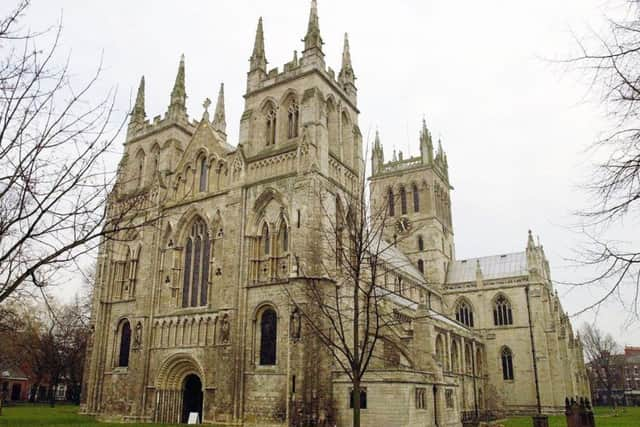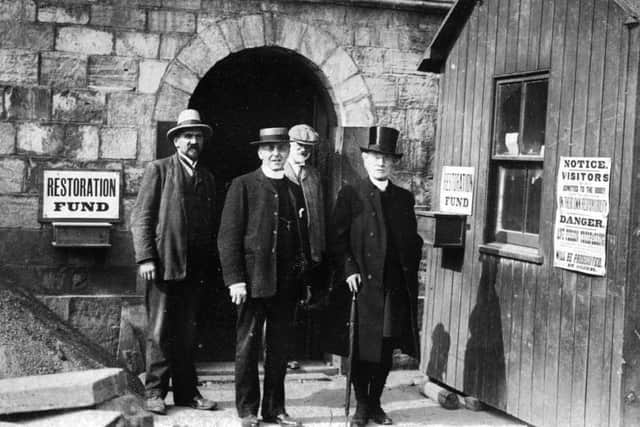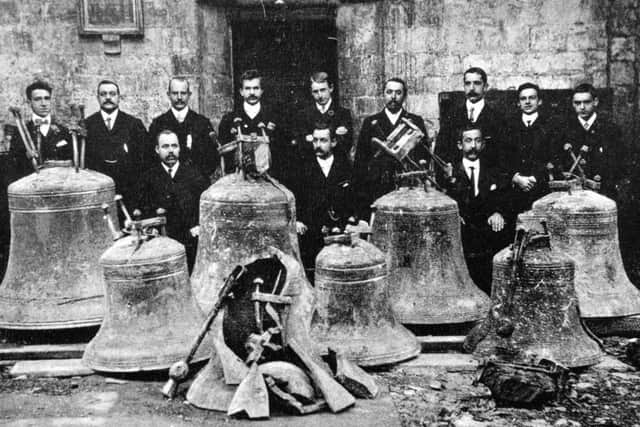Nostalgia on Tuesday: Abbey in flames
When he left his house to give the alarm, he saw that the fire was in the organ chamber itself, and there appeared to be no doubt whatever the fire originated in the organ or in that area.
The verger had left at five o’clock. He left in the church J.H. Compton, an organ repairer and builder, and James Taylor, his assistant. The two men worked together until 10. 30pm, put out all the gaslights in the Abbey, and removed the three wax candles which they had been using. They spent about 20 minutes more in and about the organ, and left the church and locked the door.
Advertisement
Hide AdAdvertisement
Hide AdThousands of people from all parts of Yorkshire visited Selby on Saturday and Sunday to gaze at the scene of desolation. Though the flames had been almost extinguished before daylight on Saturday morning, the building was still filled with burning debris, and dense clouds of smoke and steam rose. Masses of chairs and pews and charred beams were piled up in smouldering heaps and under the central tower, half-buried beneath the debris, lay a number of the fallen church bells. Overhead, the Abbey stood open to the sky from end to end, only a few charred beams left.


Miraculously, amid the general ruin, it was amazing to discover the beautiful East window had escaped with comparatively little damage.The great West window had escaped almost unscathed, while the massive Norman doors were also untouched. In the vestry, the two iron safes containing the church plate, and a massive oak box housing valuable documents and registers, were also unharmed.
Everything else, was destroyed, The altar, reredos, and choir, which some years earlier was renovated at a cost of £10,000 were completely destroyed. The organ burnt like matchwood, and the old oak pews in the church also burnt like tinder.
The Vicar of Selby saw the Archbishop of York on Saturday afternoon at Bishopthorpe and was told everything that was possible would be done to restore the Abbey. The Bishops at Hull, Sheffield and Wakefield said they would all give support. The Selby vicar noted: ‘The old part of the Abbey, the massive stone work stands as firmly and securely at this moment as I believe it ever stood.” The Abbey was insured for £10,000 and the organ £1,000.
Advertisement
Hide AdAdvertisement
Hide AdSelby Abbey, the church of St Mary and St Germain, was formerly the church of Selby Abbey. It is one of the few surviving abbey churches of the medieval period. After the dissolution of the monasteries in 1537, the abbey church struggled to survive but became the Selby parish church in 1618. The building underwent a changing fortunes. One of the most dramatic was the fall of the central Norman tower in 1690. It fell to the south, carrying with it the greater part of the transept on that side of the church. It was rebuilt in 1702 for around £100. In 1902, the tower was rebuilt and this completed a restoration which had begun earlier in the 19th century with the removal of a gallery in the Lady Chapel, and of side galleries and a plastered wall that separated the choir from the nave.


After the 1906 fire, preliminary work on the abbey was entrusted to Thos. S. Ullathorne, of Selby, under the direct supervision of J. Oldrid Scott, the architect. The work of propping up the Choir arches was pushed forward as to avoid any further disaster.
A report in The Yorkshire Post of November 10, 1906 said an official inquiry was not able to say precisely how the disastrous fire had originated and no one pointed a finger firmly at Compton or Taylor the last people in the building. But, members of the inquiry committee felt it their duty to draw attention to certain conclusions. They could not insist too strongly that much greater caution ought to be used in regard to the possession of matches by persons engaged in the building or repair of organs. Also, whenever dangerous repair work was being carried out someone ought to be on hand both night and day. They noted valuable time was lost in getting at the fire because the verger, who had the keys, lived at a considerable distance from the church.
In the aftermath of the fire, a Selby Abbey Restoration committee was formed and at a cost of over £40,000, the church was completely restored. On the first anniversary of the great fire, Selby Abbey’s restored nave was opened for Divine Service on Saturday 19 October 1907. In honour of the event, the town was decorated with flags and bunting, and streamers were strung across the principal streets.
Advertisement
Hide AdAdvertisement
Hide AdFurther restoration work was completed and celebrated with the Archbishop of York in attendance on October 19, 1909. The ceremony saw the consecration of the bells, the lectern, the chancel, the choir stalls and the pulpit. The Archbishop made an appeal to raise an additional £8,000 for the rebuilding of the south transept.


On September 26 1912, the Archbishop was back in Selby Abbey to consecrate the rebuilt south transept. It marked the completion of the great restoration scheme inaugurated in 1906. Finance for the erection of the transept was made possible through the generosity of William Liversidge of Millgate House. He was a former principal warden who in later years was a liberal benefactor to the building.
This year will see Selby Abbey hosting a number of events to celebrate its 950th anniversary. For more details visit www.selbyabbey.or.uk.